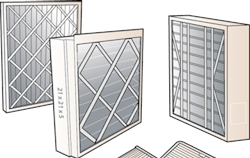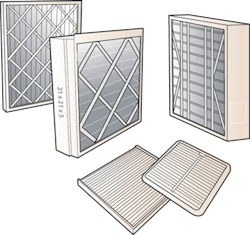A common question we get in NCI training classes is how to accurately measure pressure drop on an air handler's internal filter. Since they are always a challenge to access, I thought we could look at the wrong and right ways to handle this common situation.
Air Filters Add Airflow Resistance
Air filters create resistance to airflow. They can also reduce the air-moving ability of a Permanent Split Capacitor (PSC) fan by up to 50%. You can measure a filter's pressure drop to see how much it affects airflow in less than one minute. This test is often the missing piece that helps identify a problem in many systems.
Technicians often deal with this configuration by resorting to testing variations that could lead to inaccurate measurements.
Air handlers with internal filter racks make it difficult to measure filter pressure drop. The challenge is that the filter mounts against the indoor coil. There is little room to take a pressure measurement after the filter. Another issue is that a typical static pressure tip doesn't clear the drainTechnicians often deal with this configuration by resorting to testing variations that could lead to inaccurate measurements. The most common method involves measuring pressure with the air filter installed and then removed. Unfortunately, it's the wrong way to measure.
The Wrong Way to Test Filter Pressure Drop
Typically, a technician using this test method first measures static pressure after the internal coil in the air handler, with the filter installed. They take this reading between the coil and the inlet to the blower. Next, they take a second static pressure measurement in the same location with the filter removed. Then they subtract the two readings from each other to determine the filter pressure drop.
Here's an example: you measure the pressure after the air handler coil with the filter installed and find .40-in. w.c. (inches of water column). You then remove the filter and take a second pressure measurement. The new pressure with the filter removed is .52-in. w.c. This results in a calculated filter pressure drop of .12-in. w.c. (.52 - .40 = .12).
Why The Test is Incorrect
This test may seem sound at face value, but the result will be an inaccurate filter pressure drop. Why? Removing the filter decreases total external static pressure (TESP). Remember this rule: on a PSC fan, as static pressure decreases, fan airflow increases.
Removing the filter decreases total external static pressure (TESP). Remember this rule: on a PSC fan, as static pressure decreases, fan airflow increases.
Once you place the filter back into the air handler, the fan must overcome that added resistance. TESP increases, and fan airflow decreases because you aren't taking the readings under similar conditions. Fan airflow has changed, and failing to recognize this interaction could lead you to chase a filter problem that doesn't exist.
The Correct Way to Measure Filter Pressure Drop
To avoid the scenario above, you need to test the system under normal operating conditions – not simulated ones. To keep from altering system conditions, you must get a pressure reading after the filter – a feat many technicians claim is impossible on this installation. However, the reading is easy to get if you have the right static pressure probe.
You can make a static pressure probe. Use an 18-in. piece of 1/4-inch soft copper tubing – the type you would use to hook up a humidifier or an icemaker. Email me a request, and I'll send you instructions on how to make one. With the 18-in. straight static pressure probe, you can get in between the filter and the coil with no problem.
After you make the probe, install two test ports for measuring pressures. The following steps are only for filter pressure drop on an air handler with an internal filter rack.
1. Install a 3/8-in. test port into the return duct on the entering air side of the equipment (return plenum). This is your pressure measurement before the filter, as air enters the air handler.
2. Remove the filter door from the air handler and install a 3/8-in. test port near the top of the filter door. Use a tape measure to ensure the port allows your probe to go between the filter and coil. Note: It's best to avoid drilling into the filter door while it's on the air handler — you don't want to damage a drain pan.
3. Re-install the filter door onto the air handler. The port on the filter door provides access for your pressure measurement after the filter, just before the air enters the coil.
4. Turn on the system and ensure the fan operates at its highest speed.
5. Turn on your digital manometer and zero it.
6. Attach a hose to the (-) port of the manometer and insert the straight static pressure probe into the opposite end of the hose.
7. Insert the straight static pressure probe into the 3/8-in. test port you installed before the filter and record the reading.
8. Insert the straight static pressure probe into the 3/8-in. test port you installed in the filter door, after the filter, and record the reading.
9. Subtract the two pressures to determine the filter pressure drop.
Diagnose Filter Pressure Drop Readings
In a perfect world, filter pressure drop should not exceed 20% of the fan's maximum rated TESP. You can find this rating on the air handling equipment's data plate on the blower door.
Let's say you're testing filter pressure drop on an air handler with a maximum-rated TESP of .30-in. w.c. Multiply the maximum rated TESP by 20% or .20 to come up with the ideal filter pressure drop. In this example, filter pressure drop should not exceed .06-in. w.c. (.30 x 20% = .06).
If the filter pressure drop exceeds 20% of the maximum rated TESP, use a less restrictive filter type, increase the filter surface area, or move the filter to another location where you have more room. Filter repairs are one of the most overlooked upgrades to an HVAC system. Take a minute and see if you can serve your customers better by improving both filtration and airflow at the same time.
David Richardson serves the HVAC industry as director of training for National Comfort Institute, Inc. (NCI). NCI specializes in training that focuses on improving, measuring, and verifying HVAC and Building Performance.
If you're an HVAC contractor or technician interested in learning more about static pressure and air filters, contact David at ncilink.com/ContactMe or call 800-633-7058. NCI's website -- www.nationalcomfortinstitute.com -- is full of free technical articles and downloads to help you improve your professionalism and strengthen your company.
About the Author
David Richardson
Director, technical curriculum
David Richardson serves the HVAC industry as director of technical curriculum at National Comfort Institute, Inc. (NCI), Avon, Ohio. NCI specializes in training that focuses on improving, measuring, and verifying HVAC and Building Performance.

